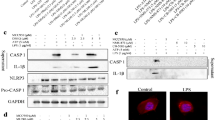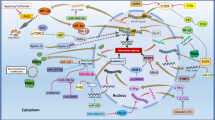Abstract
A number of structurally divergent proteins with J domains, called J proteins, interact with and activate the ATPase of Hsp70s, thereby harnessing the ATPase activity for conformational work on target proteins. The precise role of most mammalian J proteins remains undefined. In this paper, we demonstrate that transient expression of the J protein, Rdj2, in HEK 293 cells increased cellular cyclic adenosine monophosphate (cAMP) levels in the presence of the β-adrenergic agonist isoproterenol. In CNS-derived catecholaminergic neuronal cell line (CAD) neuroblastoma cells, expression of Rdj2 increased isoproterenol-stimulated phosphorylation of cAMP response element binding protein (CREB). Moreover, we have characterized the binding properties of Rdj2 and observed a direct interaction between Rdj2 and receptor-coupled trimeric GTP-binding proteins (G proteins). We further show that the composition of the Rdj2-chaperone complex and the cysteine string protein (CSPα)-chaperone complex, another J protein, is distinct. Our data demonstrate that Rdj2 modulates G protein signaling and further suggest that chaperoning G proteins is an emerging theme of the J protein network.








Similar content being viewed by others
References
Andres DA, Shao H, Crick DC, Finlin BS (1997) Expression cloning of a novel farnesylated protein, RDJ2, encoding a DnaJ protein homologue. Arch Biochem Biophys 346:113–124
Arndt V, Rogon C, Hohfeld J (2007) To be, or not to be – molecular chaperones in protein degradation. Cell Mol Life Sci 64(19–20):2525–2541
Bai L, Swayne LA, Braun JE (2007) The CSPalpha/G protein complex in PC12 cells. Biochem Biophys Res Commun 352:123–129
Beck KE, Kay JG, Braun JE (2006) Rdj2, a J protein family member, interacts with cellular prion PrP(C). Biochem Biophys Res Commun 346:866–871
Blondeau F, Ritter B, Allaire PD, Wasiak S, Girard M, Hussain NK, Angers A, Legendre-Guillemin V, Roy L, Boismenu D, Kearney RE, Bell AW, Bergeron JJ, McPherson PS (2004) Tandem MS analysis of brain clathrin-coated vesicles reveals their critical involvement in synaptic vesicle recycling. Proc Natl Acad Sci USA 101:3833–3838
Braun JE, Scheller RH (1995) Cysteine string protein, a DnaJ family member, is present on diverse secretory vesicles. Neuropharmacology 34:1361–1369
Braun JE, Wilbanks SM, Scheller RH (1996) The cysteine string secretory vesicle protein activates Hsc70 ATPase. J Biol Chem 271:25989–25993
Brown H, Larsson O, Branstrom R, Yang S, Leibiger B, Leibiger I, Fried G, Moede T, Deeney JT, Brown GR, Jacobsson G, Rhodes CJ, Braun JE, Scheller RH, Corkey BE, Berggren P, Meister B (1998) Cysteine string protein (CSP) is an insulin secretory granule-associated protein regulating beta-cell exocytosis. EMBO J 17:5048–5058
Caplan AJ, Douglas MG (1991) Characterization of YDJ1: a yeast homologue of the bacterial dnaJ protein. J Cell Biol 114:609–621
Chamberlain LH, Henry J, Burgoyne RD (1996) Cysteine string proteins are associated with chromaffin granules. J Biol Chem 271:19514–19517
Chang HC, Hull M, Mellman I (2004) The J-domain protein Rme-8 interacts with Hsc70 to control clathrin-dependent endocytosis in Drosophila. J Cell Biol 164:1055–1064
Chapple JP, Cheetham ME (2003) The chaperone environment at the cytoplasmic face of the endoplasmic reticulum can modulate rhodopsin processing and inclusion formation. J Biol Chem 278:19087–19094
Cheetham ME, Caplan AJ (1998) Structure, function and evolution of DnaJ: conservation and adaptation of chaperone function. Cell Stress Chaperones 3:28–36
Cheetham ME, Jackson AP, Anderton BH (1994) Regulation of 70-kDa heat-shock-protein ATPase activity and substrate binding by human DnaJ-like proteins, HSJ1a and HSJ1b. Eur J Biochem 226:99–107
Craig EA, Huang P, Aron R, Andrew A (2006) The diverse roles of J-proteins, the obligate Hsp70 co-chaperone. Rev Physiol Biochem Pharmacol 156:1–21
Dupre DJ, Robitaille M, Richer M, Ethier N, Mamarbachi AM, Hebert TE (2007) Dopamine receptor-interacting protein 78 acts as a molecular chaperone for Ggamma subunits before assembly with Gbeta. J Biol Chem 282:13703–13715
Eisenberg E, Greene LE (2007) Multiple roles of auxilin and hsc70 in clathrin-mediated endocytosis. Traffic 8:640–646
Frydman J, Hohfeld J (1997) Chaperones get in touch: the Hip-Hop connection. Trends Biochem Sci 22:87–92
Georgopoulos CP, Lundquist-Heil A, Yochem J, Feiss M (1980) Identification of the E. coli dnaJ gene product. Mol Gen Genet 178:583–588
Kohan SA, Pescatori M, Brecha NC, Mastrogiacomo A, Umbach JA, Gundersen CB (1995) Cysteine string protein immunoreactivity in the nervous system and adrenal gland of rat. J Neurosci 15:6230–6238
Magga JM, Jarvis SE, Arnot MI, Zamponi GW, Braun JE (2000) Cysteine string protein regulates G-protein modulation of N-type calcium channels. Neuron 28:195–204
Manzerra P, Brown IR (1996) The neuronal stress response: nuclear translocation of heat shock proteins as an indicator of hyperthermic stress. Exp Cell Res 229:35–47
Manzerra P, Rush SJ, Brown IR (1997) Tissue-specific differences in heat shock protein hsc70 and hsp70 in the control and hyperthermic rabbit. J Cell Physiol 170:130–137
Mastrogiacomo A, Parsons SM, Zampighi GA, Jenden DJ, Umbach JA, Gundersen CB (1994) Cysteine string proteins: a potential link between synaptic vesicles and presynaptic Ca2+ channels. Science 263:981–982
Mayer MP, Bukau B (2005) Hsp70 chaperones: cellular functions and molecular mechanism. Cell Mol Life Sci 62:670–684
Miller LC, Swayne LA, Chen L, Feng ZP, Wacker JL, Muchowski PJ, Zamponi GW, Braun JEA (2003a) Cysteine String Protein (CSP) inhibition of N-type calcium channels is blocked by mutant huntingtin. J Biol Chem 278:53072–53081
Miller LC, Swayne LA, Kay JG, Feng ZP, Jarvis SE, Zamponi GW, Braun JEA (2003b) Molecular detrminants of cysteine string protien modulation of N-type calcium channels. J Cell Sci 116:2967–2974
Muchowski PJ (2002) Protein misfolding, amyloid formation, and neurodegeneration: a critical role for moleclar chaperones. Neuron 35:9–12
Natochin M, Campbell TN, Barren B, Miller LC, Hameed S, Artemyev NO, Braun JE (2005) Characterization of the G alpha(s) regulator cysteine string protein. J Biol Chem 280:30236–30241
Needleman SB, Wunsch CD (1970) A general method applicable to the search for similarities in the amino acid sequence of two proteins. J Mol Biol 48:443–453
Ohlsson H, Brunner N, Engelholm LH, Lundholt BK, Weidle U, Briand P, Lykkesfeldt AE (2001) Identification of two estrogen regulated genes associated with growth regulation of human breast cancer. Mol Cell Endocrinol 182:1–11
Ohtsuka K, Hata M (2000) Mammalian HSP40/DNAJ homologs: cloning of novel cDNAs and a proposal for their classification and nomenclature. Cell Stress Chaperones 5:98–112
Prodromou C, Pearl LH (2003) Structure and functional relationships of Hsp90. Curr Cancer Drug Targets 3:301–323
Qiu XB, Shao YM, Miao S, Wang L (2006) The diversity of the DnaJ/Hsp40 family, the crucial partners for Hsp70 chaperones. Cell Mol Life Sci 63:2560–2570
Sahi C, Craig EA (2007) Network of general and specialty J protein chaperones of the yeast cytosol. Proc Natl Acad Sci USA 104:7163–7168
Sakisaka T, Meerlo T, Matteson J, Plutner H, Balch WE (2002) rab-alphaGDI activity is regulated by a Hsp90 chaperone complex. EMBO 21:6125–6135
Sever S, Skoch J, Newmyer S, Ramachandran R, Ko D, McKee M, Bouley R, Ausiello D, Hyman BT, Bacskai BJ (2006) Physical and functional connection between auxilin and dynamin during endocytosis. EMBO J 25:4163–4174
Shaner L, Morano KA (2007) All in the family: atypical Hsp70 chaperones are conserved modulators of Hsp70 activity. Cell Stress Chaperones 12:1–8
Stahl B, Tobaben S, Sudhof TC (1999) Two distinct domains in hsc70 are essential for the interaction with the synaptic vesicle cysteine string protein. Eur J Cell Biol 78:375–381
Ungewickell E, Ungewickell H, Holstein SEH, Linder R, Prasad K, Barouch W, Martin B, Greene LE, Eisenberg E (1995) Role of auxilin in uncoating clathrin-coated vesicles. Nature 378:632–635
Zhao CM, Jacobsson G, Chen D, Hakanson R, Meister B (1997) Exocytotic proteins in enterochromaffin-like (ECL) cells of the rat stomach. Cell Tissue Res 290:539–551
Zhao X, Braun AP, Braun JE (2008) Biological roles of neural J proteins. Cell Mol Life Sci, in press
Acknowledgments
This work was supported by funding from the Alberta Prion Research Institute and the Canadian Institute of Health Research. We are grateful to Dr. L. Greene (National Institute of Health) for anti-auxilin polyclonal, to Dr. E. Lafer (University of Texas) for GST-auxilin construct, to Dr. M. Nyugen (University of Calgary) for CAD neuroblastoma cells, and Dr. M Bouvier (Université de Montréal) for the pcDNA3 β2 adrenergic receptor construct. APB is an Alberta Heritage Foundation for Medical Research Senior Scholar. JEAB is an Alberta Heritage Foundation for Medical Research Senior Scholar.
Author information
Authors and Affiliations
Corresponding author
Electronic supplementary material
Below is the link to the electronic supplementary material.
Supplementary Figure 1
(A) Length of the J domain, DnaJ central region, and DnaJ C-terminal region for DnaJ, Ydj1, Rdj2, and CSPα. InterProScan was used to identify the domains. (B) Amino acid homology between the J domains of DnaJ, Ydj1, Rdj2, and CSPα. (C) Amino acid homology between the full-length sequences of DnaJ, Ydj1, and Rdj2 (PDF 93.2 KB)
Rights and permissions
About this article
Cite this article
Rosales-Hernandez, A., Beck, K.E., Zhao, X. et al. RDJ2 (DNAJA2) chaperones neural G protein signaling pathways. Cell Stress and Chaperones 14, 71–82 (2009). https://doi.org/10.1007/s12192-008-0056-y
Received:
Accepted:
Published:
Issue Date:
DOI: https://doi.org/10.1007/s12192-008-0056-y




